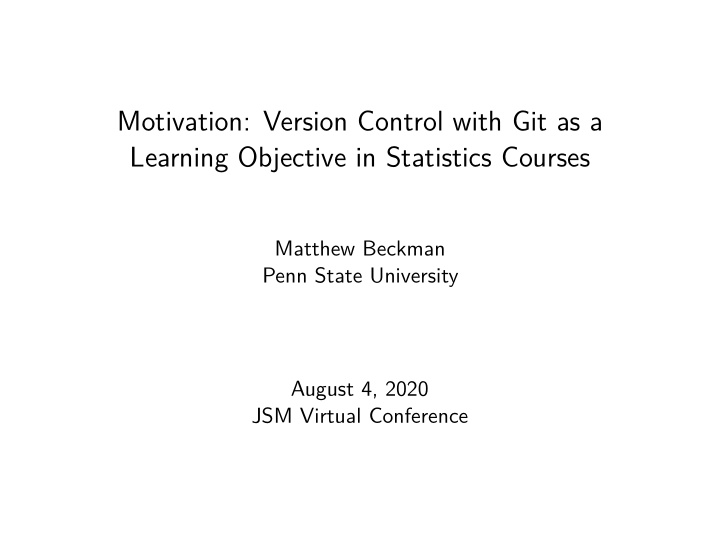



Motivation: Version Control with Git as a Learning Objective in Statistics Courses Matthew Beckman Penn State University August 4, 2020 JSM Virtual Conference
Who cares about reproducibility & VC? • American Statistical Association 123 • National Science Foundation 45 • CS education (e.g., ACM SIGCSE) 67 • Employers, Practitioners, & Students 8 1 ASA Undergraduate Guidelines Workgroup (2014) 2 DeVeaux et al. (2016); a.k.a., The Park City Report 3 Broman et al. (2017); ASA reproducibility recommendations 4 Broman et al. (2017); ASA reproducibility recommendations 5 Bollen et al. (2015); Cmte recommendations to NSF 6 Haaranen & Lehtinen (2015); SIGCSE teaching with VC 7 Zagalsky et al. (2015); SIGSCE teaching VC 8 Kaggle (2017); user survey
The Kubler-Ross model 9 . . . better known as the 5 stages of grief: • Denial: We never taught Git before, what’s the big deal?
The Kubler-Ross model 9 . . . better known as the 5 stages of grief: • Denial: We never taught Git before, what’s the big deal? • Anger: ANOTHER learning objective?! SERIOUSLY??
The Kubler-Ross model 9 . . . better known as the 5 stages of grief: • Denial: We never taught Git before, what’s the big deal? • Anger: ANOTHER learning objective?! SERIOUSLY?? • Bargaining: Can’t students just pick it up on their own?
The Kubler-Ross model 9 . . . better known as the 5 stages of grief: • Denial: We never taught Git before, what’s the big deal? • Anger: ANOTHER learning objective?! SERIOUSLY?? • Bargaining: Can’t students just pick it up on their own? • Depression: I don’t know anything about Git. . .
The Kubler-Ross model 9 . . . better known as the 5 stages of grief: • Denial: We never taught Git before, what’s the big deal? • Anger: ANOTHER learning objective?! SERIOUSLY?? • Bargaining: Can’t students just pick it up on their own? • Depression: I don’t know anything about Git. . . • Acceptance: Wait, there are buttons in RStudio? Maybe it won’t be so bad after all. . . 9 Kübler-Ross E (2005). On Grief and Grieving: Finding the Meaning of Grief Through the Five Stages of Loss. Simon & Schuster.
Reproducibility: • roughly speaking, the code “just works” with no changes needed • completely self-contained including. . . • source data • code book • package versions • all data wrangling/prep steps • recreate all analysis, models, visuals • final reporting • easy to verify results or refresh if source data updates • ethical practice
Version control (1/2) • collaboration among users • self-collaboration–e.g., RStudio Desktop and RStudio Server Figure 1: Collaboration schematic
Version control (2/2) • maintains the evolution of the project • safely explore alternative solutions/ideas in parallel Figure 2: exploring parallel solutions (https://guides.github.com/activities/hello-world/)
Reproducibility � = Version Control Sometimes lumped together as if they’re one in the same, and it’s even tempting to speak of Git(Hub) as a panacea. . . They aren’t and it isn’t. . . Our motivation: invest in good habits with a professional workflow designed to streamline both virtues.
Ethical practice • Any analysis may require hundreds of tiny decisions • Many of these decisions may be handled in private by a single person • Our work is often intended for audience without the expertise required to scrutinize those decisions With reproducibility & version control • all decisions are documented • all results can be checked • proper scrutiny is possible (now or in future)
References 1 American Statistical Association Undergraduate Guidelines Workgroup (2014). 2014 Curriculum guidelines for undergraduate programs in statistical science. Alexandria, VA: American Statistical Association. http://www.amstat.org/education/curriculumguidelines.cfm 2 Beckman, M. D., Cetinkaya-Rundel, M., Horton, N., Rundel C., Sullivan A. J., & Tackett, M. (in review). Implementing version control with Git as a learning objective in statistics courses. Preprint URL: https://arxiv.org/pdf/2001.01988.pdf 3 K. Bollen, J. T. Cacioppo, R. Kaplan, J. Krosnick, & J. L. Olds (2015). Social, Behavioral, and Economic Sciences Perspectives on Robust and Reliable Science. National Science Foundation. Arlington, VA. 4 Broman, K., Cetinkaya-Rundel, M., Nussbaum, A., Paciorek, C., Peng, R., Turek, D., & Wickham, H. (2017). Recommendations to Funding Agencies for Supporting Reproducible Research. Alexandria, VA: American Statistical Association. URL: https://www.amstat.org/asa/files/pdfs/POL-ReproducibleResearchRecommendations.pdf 5 De Veaux, R. D., et al. (2016). Curriculum Guidelines for Undergraduate Programs in Data Science. Annual Review of Statistics and Its Application, 4: 2.1-2.16. URL: https://www.annualreviews.org/doi/abs/10.1146/annurev-statistics-060116-053930 6 Haaranen, L. & Lehtinen, T. (2015). Teaching git on the side: Version control system as a course platform, in Proceedings of the 2015 ACM Conference on Innovation and Technology in Computer Science Education , ITiCSE ’15, ACM, New York, NY, USA, pp. 87–92. URL: http://doi.acm.org/10.1145/2729094.2742608 7 Kaggle (2017). Kaggle machine learning & data science survey 2017. URL: https://www.kaggle.com/kaggle/kaggle-survey-2017 8 Zagalsky, A., Feliciano, J., Storey, M.-A., Zhao, Y. & Wang, W. (2015). The emergence of GitHub as a collaborative platform for education, in Proceedings of the 18th ACM Conference on Computer Supported Cooperative Work & Social Computing , CSCW ’15, ACM, New York, NY, USA, pp. 1906–1917.
Thank You Motivation: Version Control with Git as a Learning Objective in Statistics Courses Matthew Beckman Penn State University August 4, 2020 JSM Virtual Conference https://mdbeckman.github.io/JSM2020-Virtual/
Recommend
More recommend